Retrieval of Chlorophyll a Concentration Using GOCI Data in Sediment-Laden Turbid Waters of Hangzhou Bay and Adjacent Coastal Waters
Abstract
1. Introduction
2. Data and Methods
2.1. Study Area
2.2. Field Data
2.3. GOCI Data
2.4. Atmospheric Correction of GOCI Data
2.4.1. Rayleigh Scattering Correction
2.4.2. Cloud Masking
2.4.3. Correction of Aerosol Contribution
2.5. Related Chl-a Retrieval Algorithms
2.5.1. Regional Chl-a Retrieval Algorithm in Highly Turbid Water around Hangzhou Bay
2.5.2. The OC3 Algorithm Used in the GOCI Level 2 Operational Chl-a Data Product
2.5.3. Preprocessing for an Improved Chl-a Retrieval Algorithm in This Study
2.6. Accuracy Assessment Indicators
2.7. Spectral Clustering Analysis
3. Results
3.1. Comparison between Rrs Derived in This Study and Operational Level 2 Data Products
3.2. The Improved Chl-a Retrieval Algorithm in This Study
3.3. Seasonal Variations in Chl-a in Hangzhou Bay
3.4. Classification of Chl-a Seasonal Cycle
4. Discussion
4.1. Comparison of Multitemporal Observations for Hangzhou Bay
4.2. Seasonal Variation in Chl-a in Hangzhou Bay
4.3. Limitations of the Atmospheric Correction Procedure and Retrieval Algorithms in This Study
5. Conclusions
Author Contributions
Funding
Institutional Review Board Statement
Informed Consent Statement
Data Availability Statement
Acknowledgments
Conflicts of Interest
References
- Miranda, J.; Baliarsingh, S.K.; Lotliker, A.A.; Sahoo, S.; Sahu, K.C.; Kumar, T.S. Long-term trend and environmental determinants of phytoplankton biomass in coastal waters of northwestern Bay of Bengal. Environ. Monit. Assess. 2020, 192, 55. [Google Scholar] [CrossRef] [PubMed]
- Cullen, J. The deep chlorophyll maximum—Comparing vertical profiles of chlorophyll-a. Can. J. Fish. Aquat. Sci. 1982, 39, 791–803. [Google Scholar] [CrossRef]
- Steele, J. Environmental control of photosynthesis in the Sea. Limnol. Oceanogr. 1962, 7, 137–150. [Google Scholar] [CrossRef]
- Costa, D.D.S.; Jansen Cutrim, M.V. Spatial and seasonal variation in physicochemical characteristics and phytoplankton in an estuary of a tropical delta system. Reg. Stud. Mar. Sci. 2021, 44, 101746. [Google Scholar] [CrossRef]
- Tian, B.; Wu, W.; Yang, Z.; Zhou, Y. Drivers, trends, and potential impacts of long-term coastal reclamation in China from 1985 to 2010. Estuar. Coast. Shelf. Sci. 2016, 170, 83–90. [Google Scholar] [CrossRef]
- Dasgupta, S.; Singh, R.P.; Kafatos, M. Comparison of global chlorophyll concentrations using MODIS data. Adv. Space Res. 2009, 43, 1090–1100. [Google Scholar] [CrossRef]
- Antoine, D. Ocean-Colour Observations from a Geostationary Orbit; International Ocean Color Coordinating Group (IOCCG): Dartmouth, NS, Canada, 2012; Available online: https://repository.oceanbestpractices.org/handle/11329/523 (accessed on 4 December 2022).
- Ryu, J.; Han, H.; Cho, S.; Park, Y.; Ahn, Y. Overview of Geostationary Ocean Color Imager (GOCI) and GOCI Data Processing System (GDPS). Ocean Sci. J. 2012, 47, 223–233. [Google Scholar] [CrossRef]
- Hu, C.; Carder, K.L.; Muller-Karger, F.E. Atmospheric correction of SeaWiFS imagery over turbid coastal waters: A practical method. Remote Sens. Environ. 2000, 74, 195–206. [Google Scholar] [CrossRef]
- Wang, M.; Shi, W. Estimation of ocean contribution at the MODIS near-infrared wavelengths along the east coast of the U.S.: Two case studies. Geophys. Res. Lett. 2005, 32, L13606. [Google Scholar] [CrossRef]
- Wang, M.; Shi, W.; Tang, J. Water property monitoring and assessment for China’s inland Lake Taihu from MODIS-Aqua measurements. Remote Sens. Environ. 2011, 115, 841–854. [Google Scholar] [CrossRef]
- Bai, R.; He, X.; Bai, Y.; Gong, F.; Zhu, Q.; Wang, D.; Li, T. Atmospheric correction algorithm based on the interpolation of ultraviolet and shortwave infrared bands. Opt. Express 2023, 31, 6805–6826. [Google Scholar] [CrossRef] [PubMed]
- Tian, L.; Zeng, Q.; Tian, X.; Li, J.; Wang, Z.; Li, W. Water environment remote sensing atmospheric correction of Geostationary Ocean Color Imager data over turbid coastal waters in the Bohai Sea using artificial neural networks. Curr. Sci. 2016, 110, 1079–1085. [Google Scholar] [CrossRef]
- Wang, J.; Wang, Y.; Lee, Z.; Wang, D.; Chen, S.; Lai, W. A revision of NASA SeaDAS atmospheric correction algorithm over turbid waters with artificial Neural Networks estimated remote-sensing reflectance in the near-infrared. Isprs. J. Photogramm. 2022, 194, 235–249. [Google Scholar] [CrossRef]
- Gordon, H.; Wang, M. Retrieval of water-leaving radiance and aerosol optical-thickness over the oceans with SeaWiFS—A preliminary algorithm. Appl. Opt. 1994, 33, 443–452. [Google Scholar] [CrossRef]
- Howard, R.; Gordon, A.Y.M. Remote Assessment of Ocean Color for Interpretation of Satellite Visible Imagery; Springer: London, UK, 1983; ISBN 9780387909233. [Google Scholar]
- O’Reilly, J.E.; Werdell, P.J. Chlorophyll algorithms for ocean color sensors—OC4, OC5 & OC6. Remote Sens. Environ. 2019, 229, 32–47. [Google Scholar] [CrossRef]
- O’Reilly, J.E.; Maritorena, S.; Mitchell, B.G.; Siegel, D.A.; Carder, K.L.; Garver, S.A.; Kahru, M.; McClain, C. Ocean color chlorophyll algorithms for SeaWiFS. J. Geophys. Res. 1998, 103, 24937–24953. [Google Scholar] [CrossRef]
- Kim, W.; Moon, J.; Park, Y.; Ishizaka, J. Evaluation of chlorophyll retrievals from Geostationary Ocean Color Imager (GOCI) for the North-East Asian region. Remote Sens. Environ. 2016, 184, 482–495. [Google Scholar] [CrossRef]
- Gilerson, A.A.; Gitelson, A.A.; Zhou, J.; Gurlin, D.; Moses, W.; Ioannou, I.; Ahmed, S.A. Algorithms for remote estimation of chlorophyll-a in coastal and inland waters using red and near infrared bands. Opt. Express 2010, 18, 24109–24125. [Google Scholar] [CrossRef]
- Shen, F.; Zhou, Y.; Li, D.; Zhu, W.; Salama, M.S. Medium resolution imaging spectrometer (MERIS) estimation of chlorophyll-a concentration in the turbid sediment-laden waters of the Changjiang (Yangtze) Estuary. Int. J. Remote Sens. 2010, 31, 4635–4650. [Google Scholar] [CrossRef]
- Zhang, F.; Zhang, B.; Li, J.; Shen, Q.; Wu, Y.; Wang, G.; Zou, L.; Wang, S. Validation of a synthetic chlorophyll index for remote estimates of chlorophyll-a in a turbid hypereutrophic lake. Int. J. Remote Sens. 2014, 35, 289–305. [Google Scholar] [CrossRef]
- Siswanto, E.; Tang, J.; Yamaguchi, H.; Ahn, Y.; Ishizaka, J.; Yoo, S.; Kim, S.; Kiyomoto, Y.; Yamada, K.; Chiang, C.; et al. Empirical ocean-color algorithms to retrieve chlorophyll-a, total suspended matter, and colored dissolved organic matter absorption coefficient in the Yellow and East China Seas. J. Oceanogr. 2011, 67, 627–650. [Google Scholar] [CrossRef]
- Lins, R.C.; Martinez, J.; Marques, D.D.M.; Cirilo, J.A.; Fragoso, C.R. Assessment of chlorophyll-a remote sensing algorithms in a productive tropical estuarine-lagoon system. Remote Sens. 2017, 9, 516. [Google Scholar] [CrossRef]
- Le, C.; Li, Y.; Zha, Y.; Sun, D.; Huang, C.; Lu, H. A four-band semi-analytical model for estimating chlorophyll a in highly turbid lakes: The case of Taihu Lake, China. Remote Sens. Environ. 2009, 113, 1175–1182. [Google Scholar] [CrossRef]
- Yi, C.; An, J. A four-band quasi-analytical algorithm with MODIS bands for estimating chlorophyll-a concentration in turbid coastal waters. J. Indian Soc. Remote 2014, 42, 839–850. [Google Scholar] [CrossRef]
- Lee, Z.; Carder, K.L. Absorption spectrum of phytoplankton pigments derived from hyperspectral remote-sensing reflectance. Remote Sens. Environ. 2004, 89, 361–368. [Google Scholar] [CrossRef]
- Hu, Y.; Yu, Z.; Zhou, B.; Li, Y.; Yin, S.; He, X.; Peng, X.; Shum, C.K. Tidal-driven variation of suspended sediment in Hangzhou Bay based on GOCI data. Int. J. Appl. Earth Obs. 2019, 82, 101920. [Google Scholar] [CrossRef]
- Shi, J.Z. Tide-induced fine sediment resuspension in the well-mixed Hangzhou Bay, East China Sea, China. Earth Environ. Sci. Trans. R. Soc. Edinb. 2011, 102, 25–34. [Google Scholar] [CrossRef]
- Feng, J.; Chen, H.; Zhang, H.; Li, Z.; Yu, Y.; Zhang, Y.; Bilal, M.; Qiu, Z. Turbidity estimation from GOCI satellite data in the turbid estuaries of China’s coast. Remote Sens. 2020, 12, 3770. [Google Scholar] [CrossRef]
- Yin, W.; Huang, D. Applications of geostationary satellite data in the study of ocean and coastal short-term processes: Two cases in the East China Sea. In Remote Sensing of Ocean and Coastal Environments; Rani, M., Seenipandi, K., Rehman, S., Kumar, P., Sajjad, H., Eds.; Elsevier: Amsterdam, The Netherlands, 2020; pp. 139–154. ISBN 978-0-12-819604-5. [Google Scholar]
- Cao, F.; Dai, K.; Tao, Q.; Fan, C.; He, L. Analysis of pollution status and research on treatment countermeasures in the coastal waters of Hangzhou Bay area. Environ. Sci. Technol. 2020, 43, 60–69. (In Chinese) [Google Scholar]
- Wu, M.; Xu, J.; Feng, Y. Spatial and temporal distribution of sediment content in the mouth of Hangzhou Bay. J. Sediment Res. 2011, 1, 33–37. (In Chinese) [Google Scholar]
- Lu, S.; He, M.; He, S.; He, S.Y.; Pan, Y.; Yin, W.; Li, P. An improved cloud masking method for GOCI data over turbid coastal waters. Remote Sens. 2021, 13, 2722. [Google Scholar] [CrossRef]
- Nordkvist, K.; Loisel, H.; Gaurier, L.D. Cloud masking of SeaWiFS images over coastal waters using spectral variability. Opt. Express 2009, 17, 12246–12258. [Google Scholar] [CrossRef] [PubMed]
- He, X.; Bai, Y.; Pan, D.; Huang, N.; Dong, X.; Chen, J.; Chen, C.A.; Cui, Q. Using geostationary satellite ocean color data to map the diurnal dynamics of suspended particulate matter in coastal waters. Remote Sens. Environ. 2013, 133, 225–239. [Google Scholar] [CrossRef]
- Han, Z.; Yun, C.; Jiang, X. Experimental study on reflection spectral characteristics of suspended sediment. J. Hydraul. Eng. 2003, 34, 118–122. (In Chinese) [Google Scholar]
- Von Luxburg, U. A tutorial on spectral clustering. Stat. Comput. 2007, 17, 395–416. [Google Scholar] [CrossRef]
- Shi, J.; Malik, J. Normalized cuts and image segmentation. IEEE Trans. Pattern Anal. 2000, 22, 888–905. [Google Scholar] [CrossRef]
- Hao, Q.; Chai, F.; Xiu, P.; Bai, Y.; Chen, J.; Liu, C.; Le, F.; Zhou, F. Spatial and temporal variation in chlorophyll a concentration in the Eastern China Seas based on a locally modified satellite dataset. Estuar. Coast. Shelf Sci. 2019, 220, 220–231. [Google Scholar] [CrossRef]
- Hooker, S.B.; Esaias, W.E.; Feldman, G.C.; Gregg, W.W.; McClain, C.R. An Overview of SeaWiFS and Ocean Color; NASA Goddard Space Flight Center: Greenbelt, ML, USA, 1992. [Google Scholar]
- Zhang, Y.; Ding, Y.; Li, T.; Xue, B.; Guo, Y. Seasonal variation of chlorophyll a and primary productivity in the East China Sea. Oceanol. et Limnol. Sin. 2016, 47, 261–268. (In Chinese) [Google Scholar]
- Shen, X.; Hu, F. Basic characteristics of chlorophyll a distribution in the waters outside the Yangtze Estuary. J. Fish. Sci. China 1995, 2, 71–80. (In Chinese) [Google Scholar]
- Wang, Y.; Chen, J.; Zhou, F.; Zhang, W.; Hao, Q. Spatial and temporal variations of chlorophyll a and primary productivity in the Hangzhou Bay. J Mar. Sci. Eng. 2022, 10, 356. [Google Scholar] [CrossRef]
- Cai, L.; Yu, M.; Yan, X.; Zhou, Y.; Chen, S. HY-1C/D reveals the chlorophyll-a concentration distribution details in the intensive islands’ waters and its consistency with the distribution of fish spawning ground. Remote Sens. 2022, 14, 4270. [Google Scholar] [CrossRef]
- Sha, H.; Li, X.; Yang, W.; Li, J. Inversion of interannual changes of sea surface temperature and chlorophyll a concentration from MODIS remote sensing data in the East China Sea. J. Dalian Fish. Univ. 2009, 24, 151–156. (In Chinese) [Google Scholar]
- Chen, J.; Zhang, M.; Cui, T.; Wen, Z. A review of some important technical problems in respect of satellite remote sensing of chlorophyll-a concentration in coastal waters. IEEE J. Sel. Top. Appl. Earth Obs. Remote Sens. 2013, 6, 2275–2289. [Google Scholar] [CrossRef]
- Ning, X.; Liu, Z. Assessment of primary productivity and potential fishery productivity in the Bohai, Yellow and East China Seas. Acta Oceanol. Sin. 1995, 17, 72–84. (In Chinese) [Google Scholar]
- Zhang, J.; Shen, F.; Yu, X.; Zhou, Y. Winter and summer variation of phytoplankton absorption in the adjacent waters of Hangzhou Bay. Geogr. Geo-Inf. Sci. 2013, 29, 116–122. (In Chinese) [Google Scholar]
- Shu, X.; Yin, Q.; Kuang, D. Relationship between chlorophyll concentration and reflection spectral characteristics of algae in inland water. J. Remote Sens. 2000, 4, 41–45. (In Chinese) [Google Scholar]
- Han, L.; Rundquist, D.C.; Liu, L.L.; Fraser, R.N.; Schalles, J.F. The spectral responses of algal chlorophyll in water with varying levels of suspended sediment. Int. J. Remote Sens. 1994, 15, 3707–3718. [Google Scholar] [CrossRef]
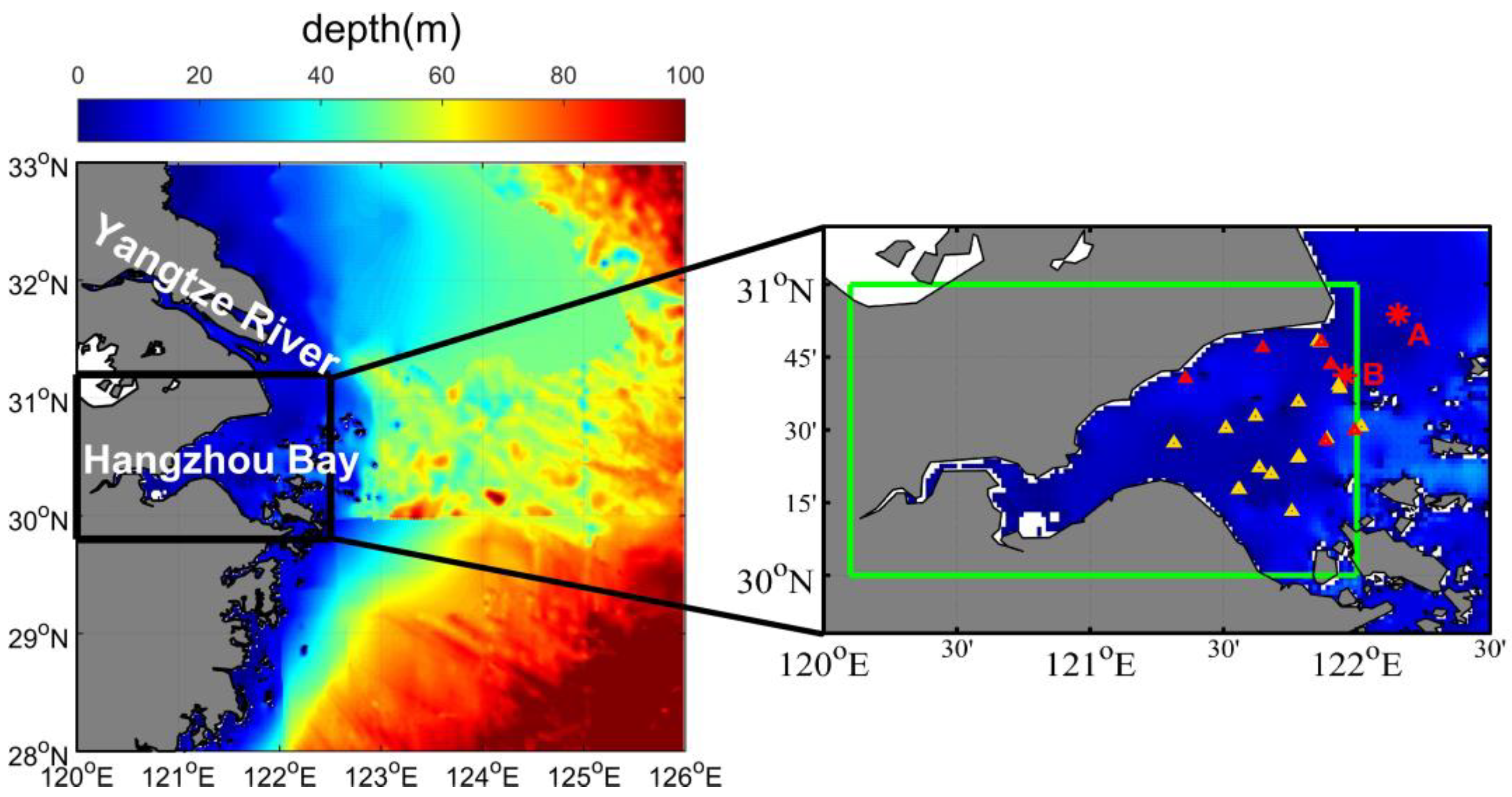
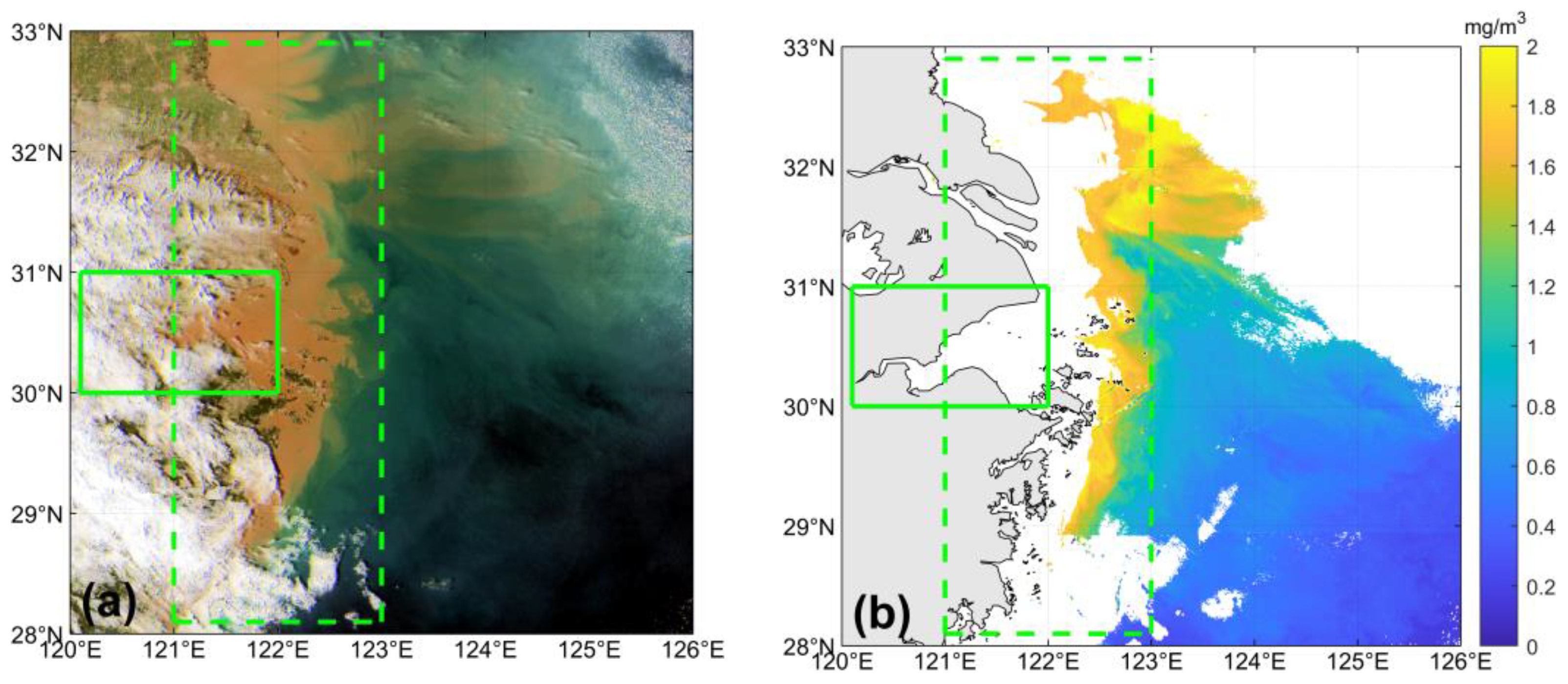

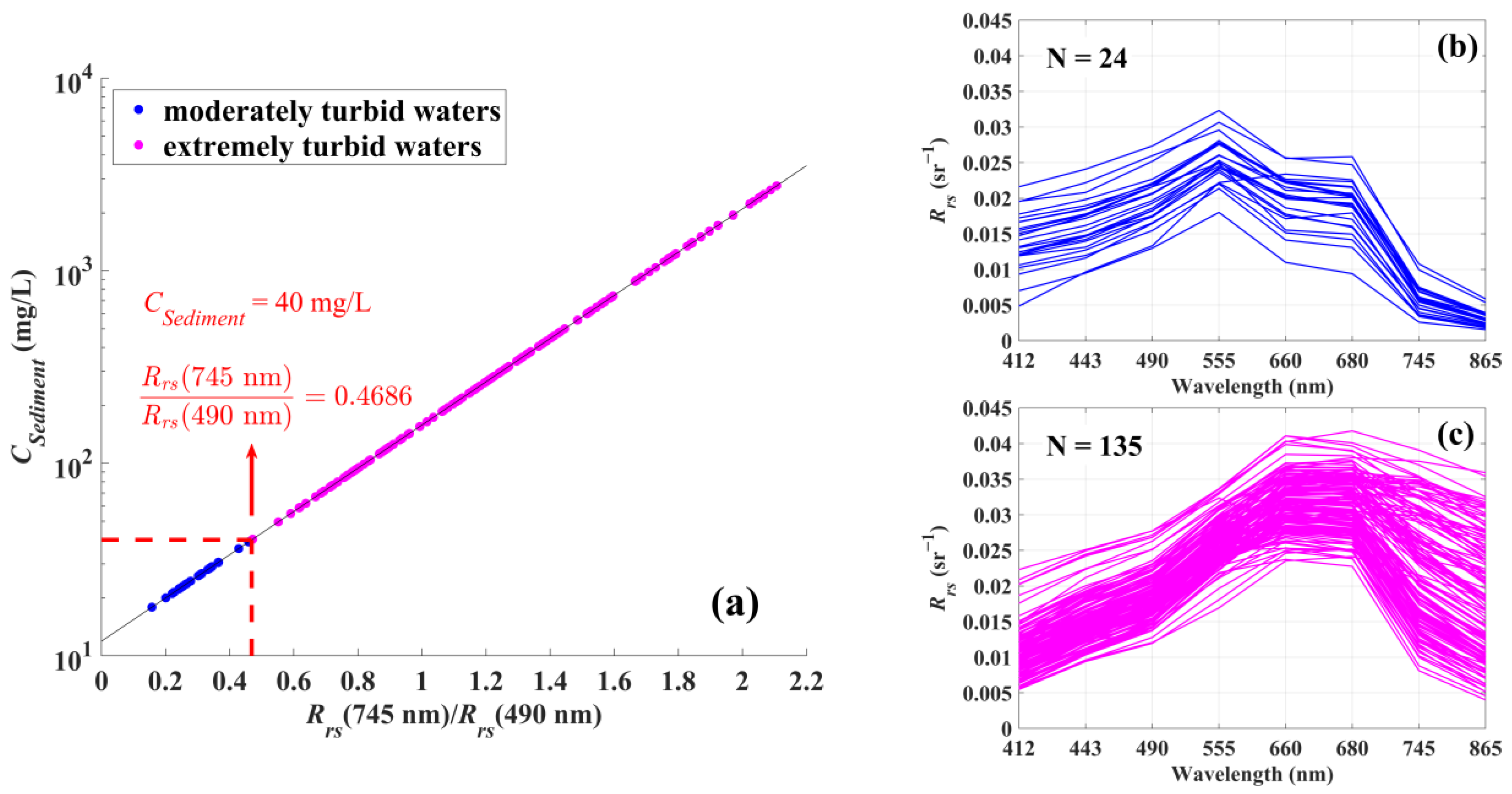
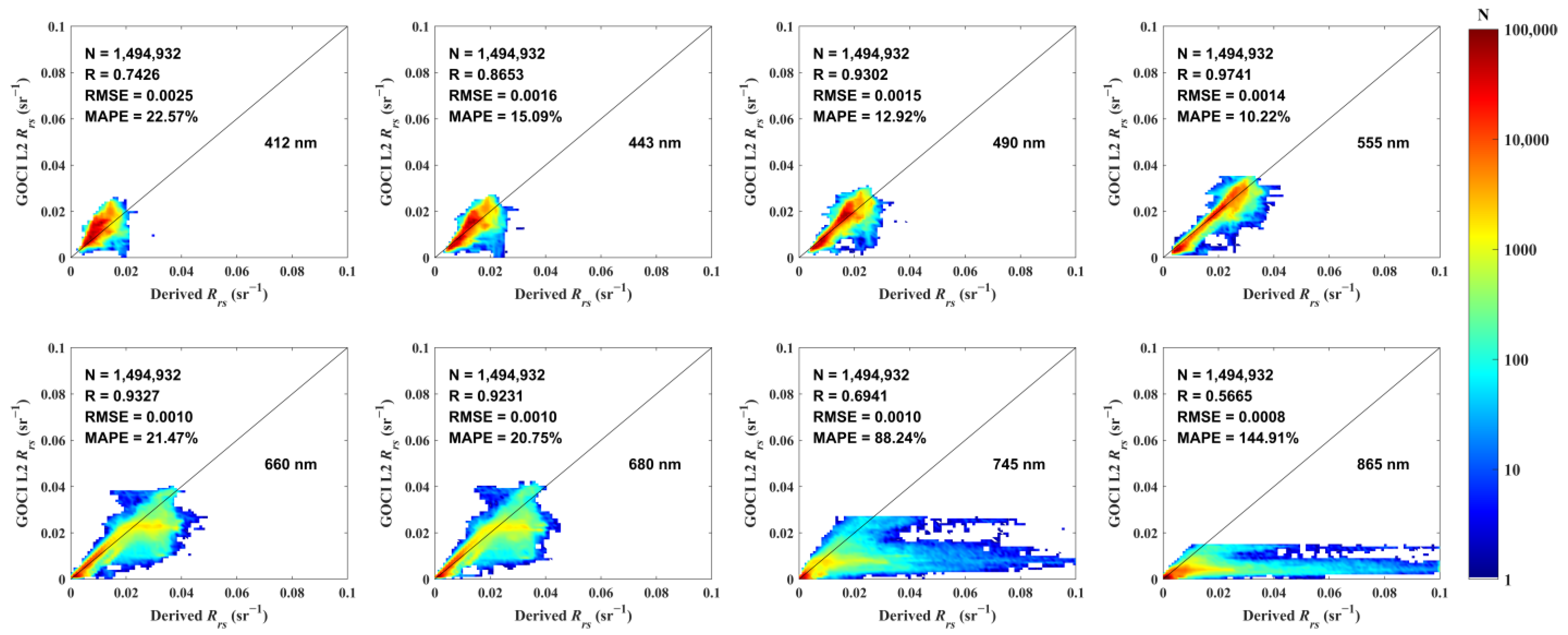

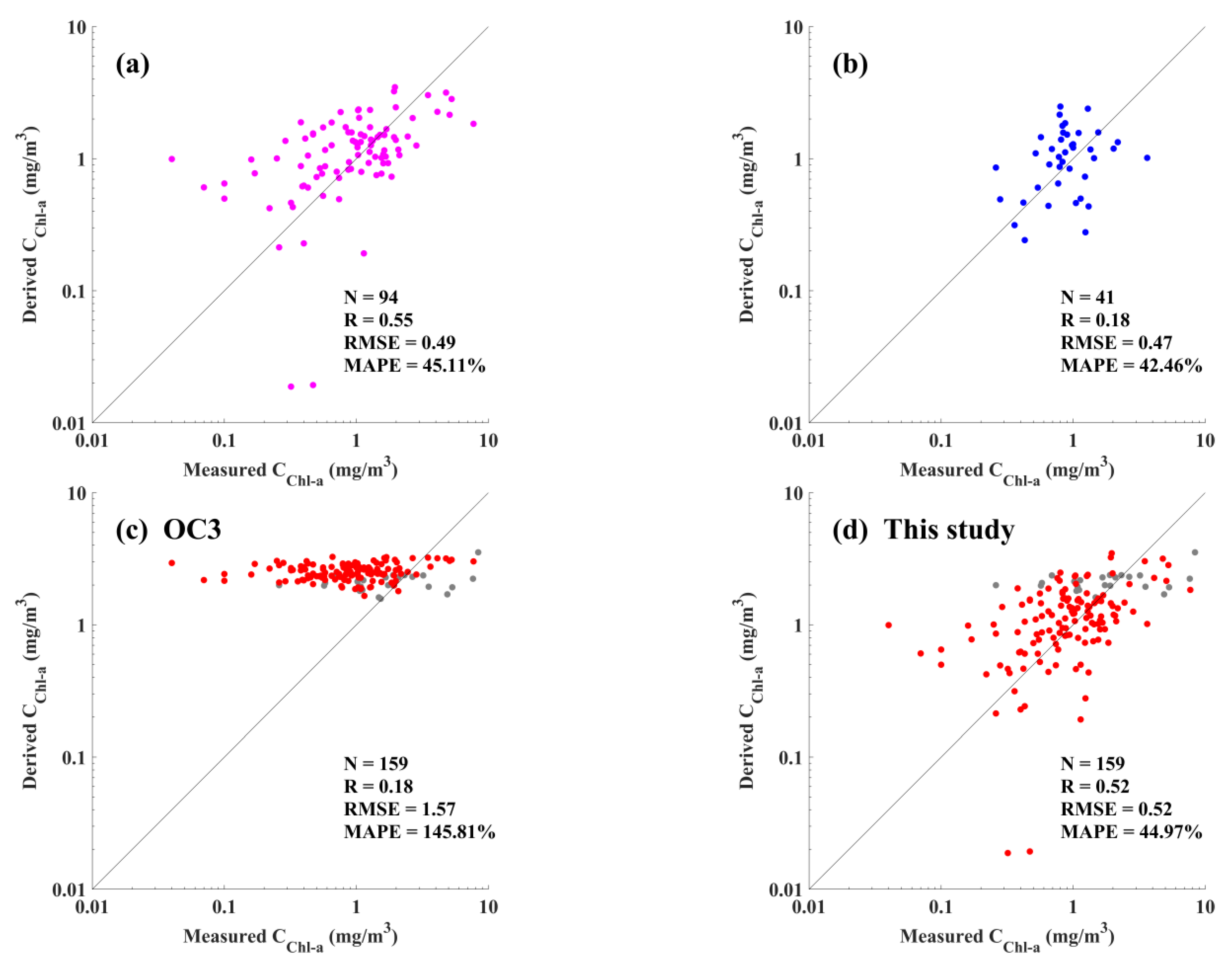

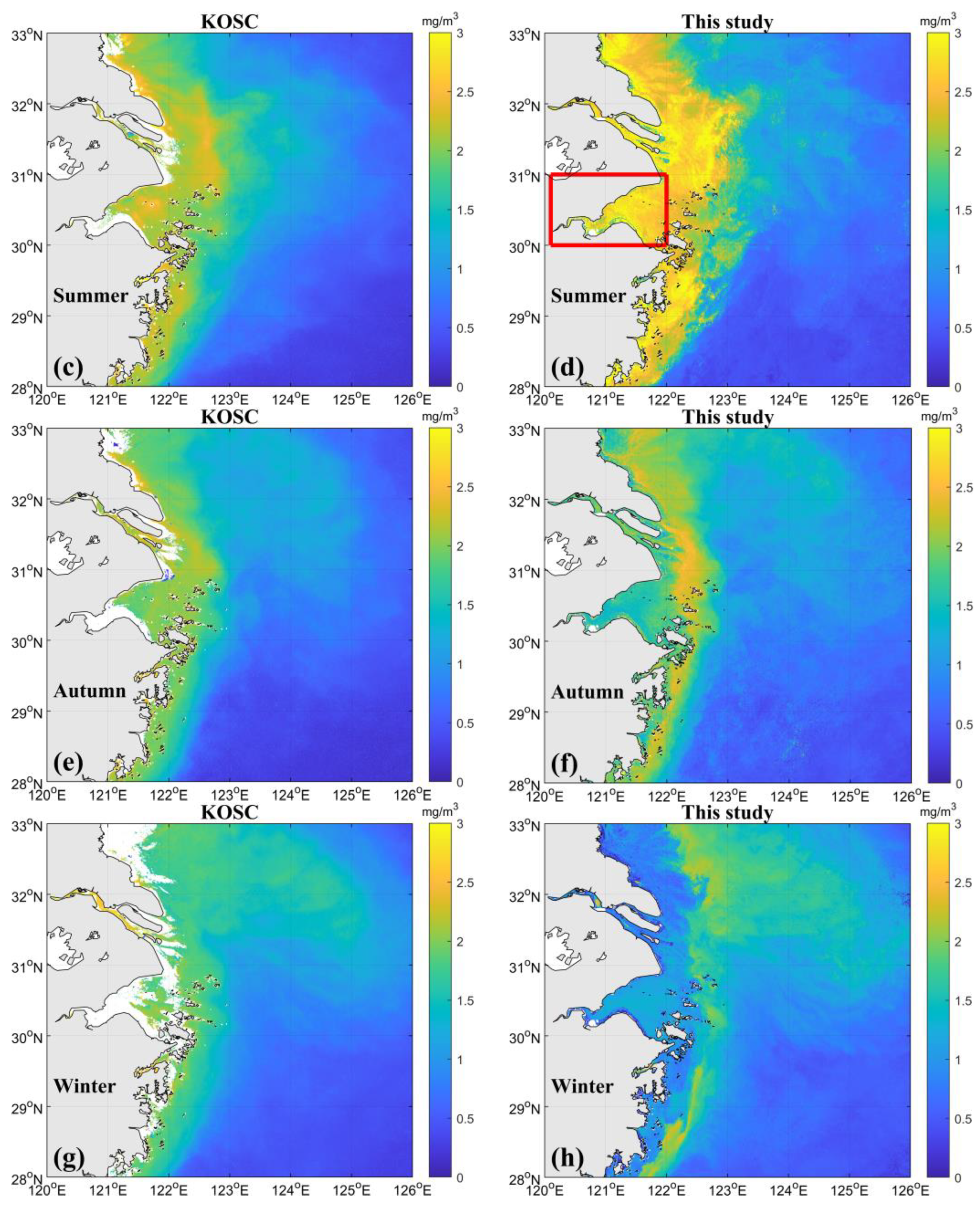
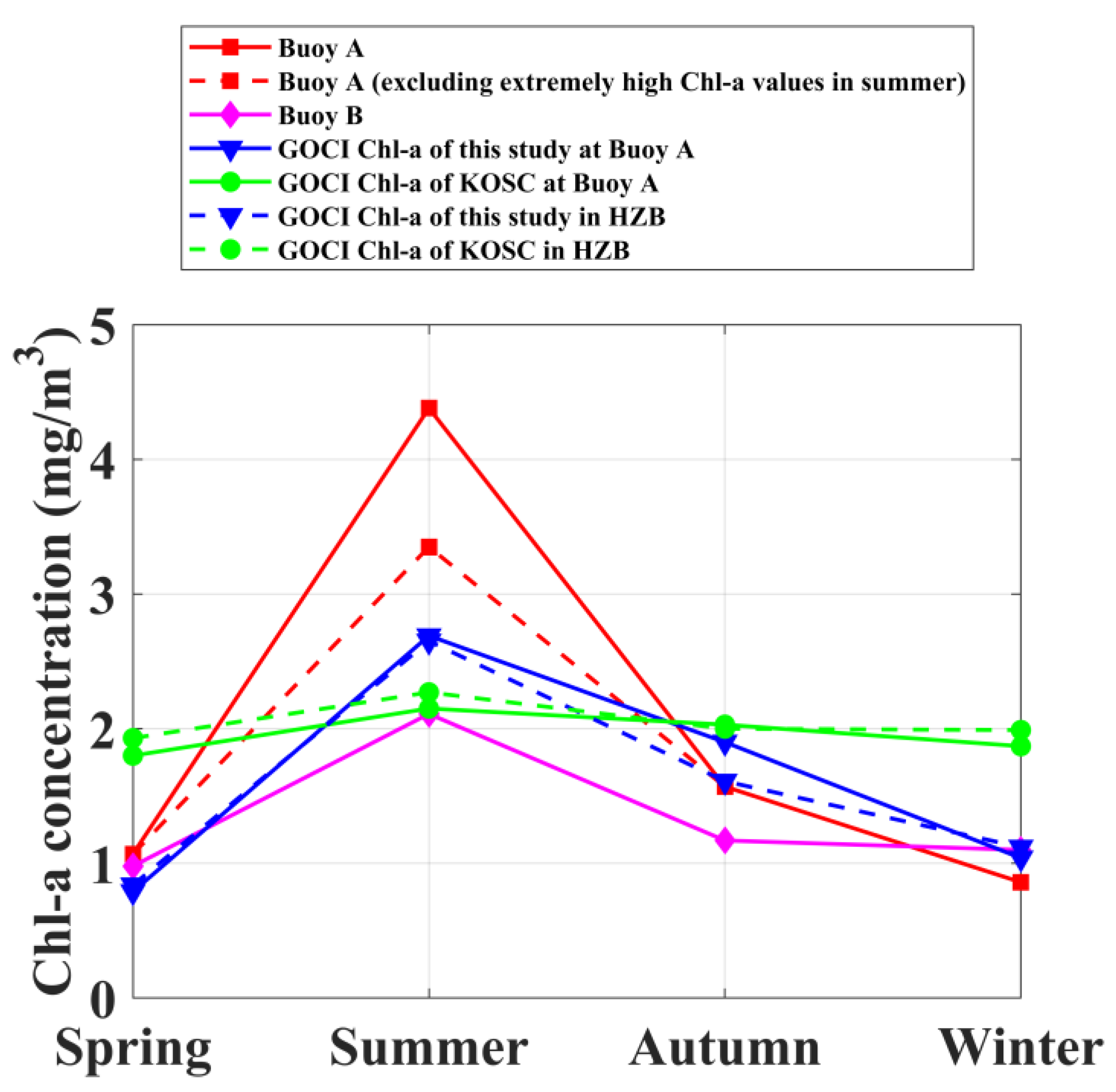
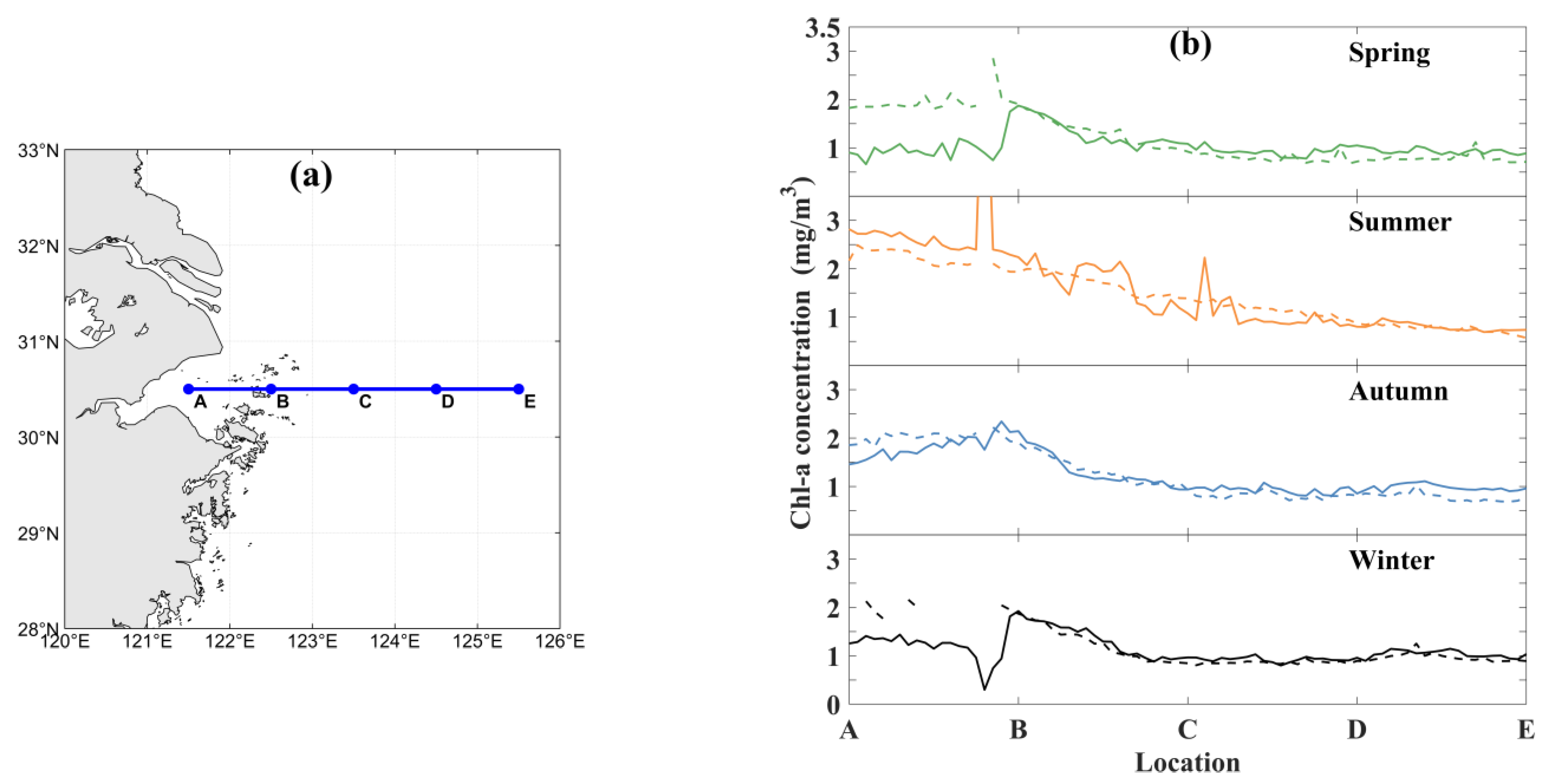
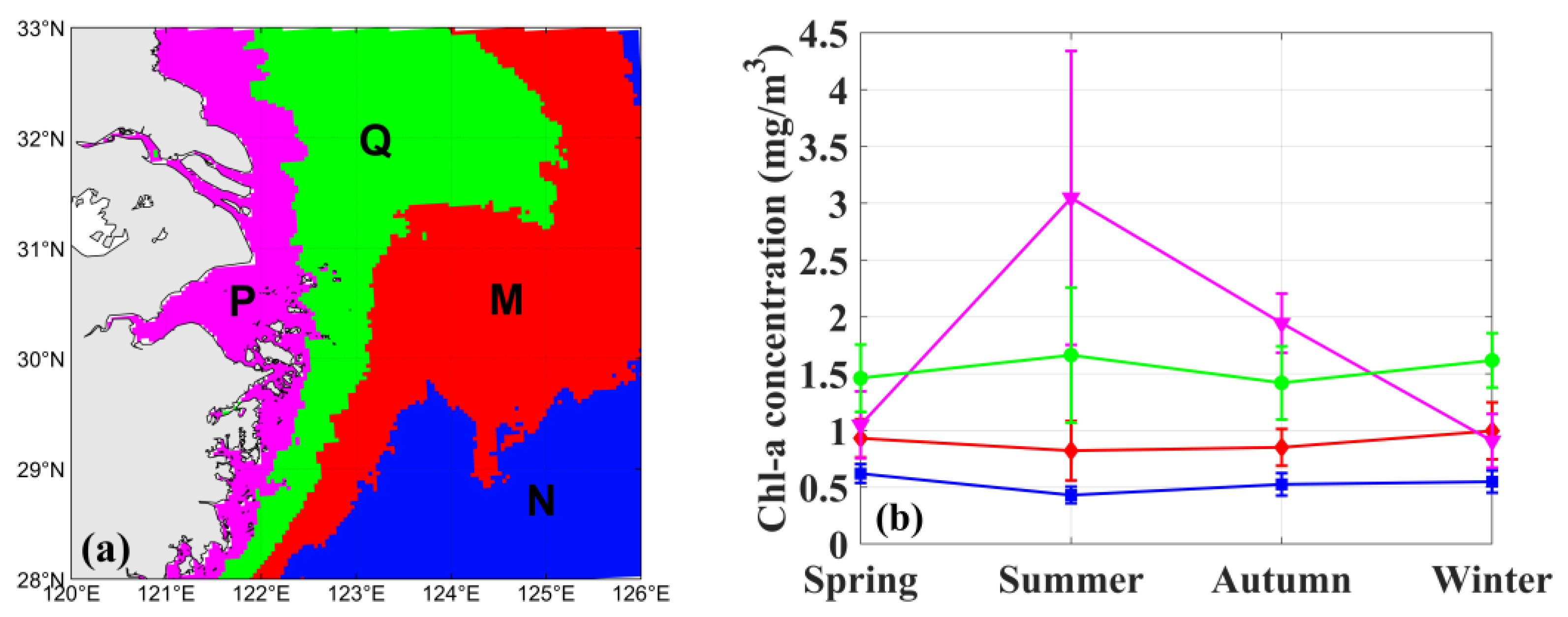
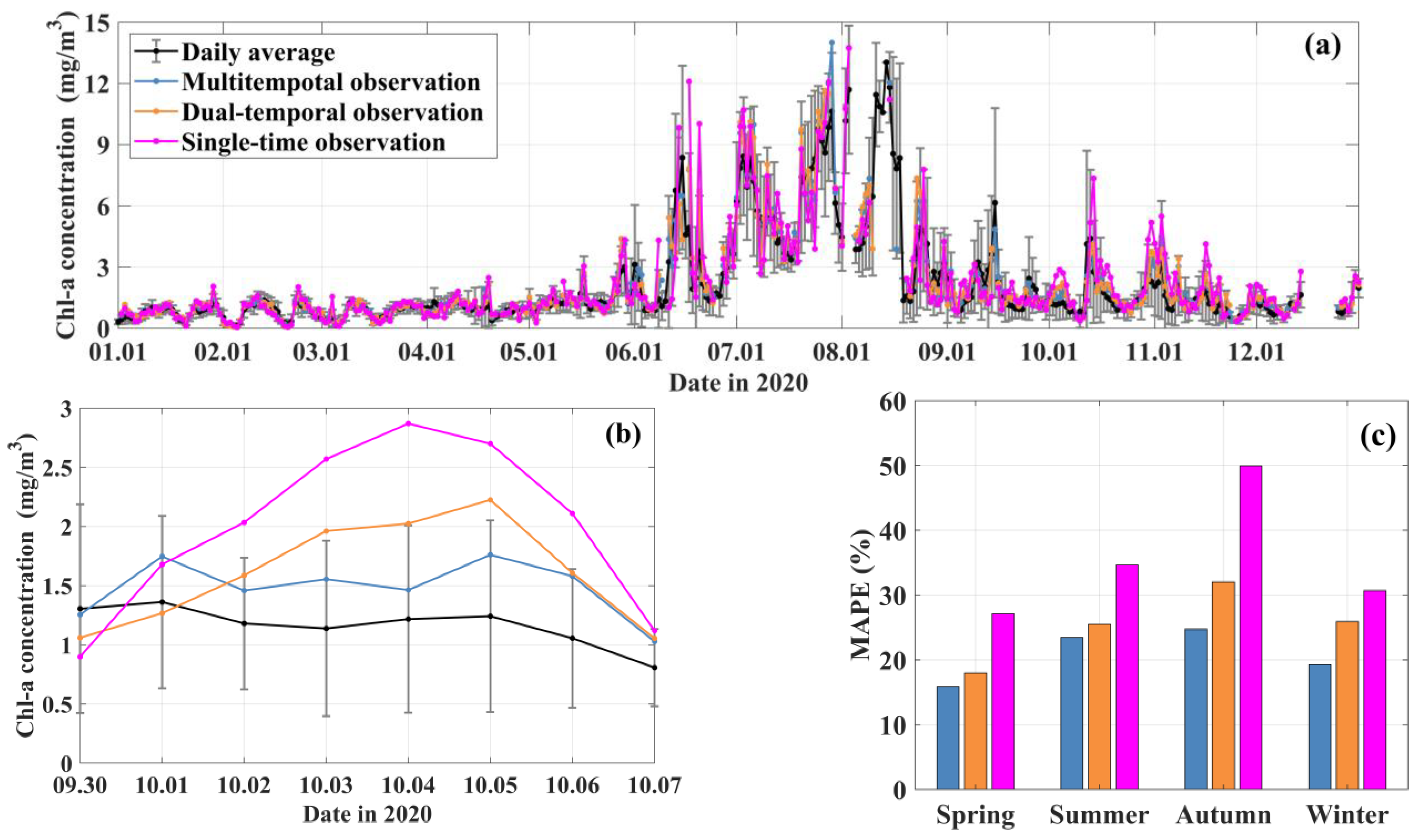
| Wavelength (nm) | La (W·m2·sr−1) |
|---|---|
| 412, 443 | 0~3 |
| 490, 555 | 0~4 |
| 660, 680, 745 | 0~4.5 |
| 865 | 0~3.5 |
| Seasons | N | R | MAPE (%) | RMSE (mg/m3) | |
|---|---|---|---|---|---|
| Spring | 17 | 0.62 | 36.76 | 0.31 | |
| Summer | 9 | 0.58 | 33.73 | 0.58 | |
| Autumn | 24 | 0.32 | 72.02 | 1.00 | |
| Winter | 44 | 0.38 | 43.89 | 0.39 |
| Category | Accuracy Indicator | This Study | OC3 | ||||
|---|---|---|---|---|---|---|---|
| All | Extremely Turbid Water | Moderately Turbid Water | All | Extremely Turbid Water | Moderately Turbid Water | ||
| Calibration | N | 94 | 94 | / | 94 | 94 | / |
| MAPE (%) | 45.11 | 45.11 | / | 144.10 | 144.10 | / | |
| RMSE (mg/m3) | 0.49 | 0.49 | / | 1.56 | 1.56 | / | |
| * P±35% (%) | 37.23 | 37.23 | / | 13.83 | 13.83 | / | |
| Validation | N | 41 | 41 | / | 41 | 41 | / |
| MAPE (%) | 42.46 | 42.46 | / | 200.68 | 200.68 | / | |
| RMSE (mg/m3) | 0.47 | 0.47 | / | 1.72 | 1.72 | / | |
| * P±35% (%) | 39.02 | 39.02 | / | 4.88 | 4.88 | / | |
| Total | N | 159 | 135 | 24 | 159 | 135 | 24 |
| MAPE (%) | 44.97 | 44.85 | 60.84 | 145.81 | 167.05 | 60.84 | |
| RMSE (mg/m3) | 0.52 | 0.47 | 0.86 | 1.57 | 1.57 | 0.86 | |
| * P±35% (%) | 37.74 | 37.78 | 37.50 | 15.09 | 11.11 | 37.50 | |
| Spring | Summer | Autumn | Winter | |
|---|---|---|---|---|
| Chl-a of Buoy A | 1.07 ± 0.67 | 4.38 ± 3.25 | 1.57 ± 1.57 | 0.86 ± 0.57 |
| Chl-a of Buoy A (excluding extremely high Chl-a values in summer) * | 1.07 ± 0.67 | 3.35 ± 2.85 | 1.57 ± 1.57 | 0.86 ± 0.57 |
| Chl-a of Buoy B | 0.98 ± 0.56 | 2.11 ± 2.71 | 1.17 ± 1.02 | 1.10 ± 0.67 |
| GOCI Chl-a of this study at Buoy A | 0.79 ± 0.48 | 2.69 ± 2.31 | 1.90 ± 0.64 | 1.04 ± 0.45 |
| GOCI Chl-a of the KOSC at Buoy A | 1.80 ± 0.16 | 2.15 ± 0.25 | 2.03 ± 0.25 | 1.87 ± 0.20 |
| GOCI Chl-a of this study in HZB | 0.84 ± 0.17 | 2.65 ± 0.33 | 1.61 ± 0.28 | 1.12 ± 0.29 |
| GOCI Chl-a of the KOSC in HZB | 1.93 ± 0.30 | 2.27 ± 0.29 | 2.00 ± 0.34 | 1.99 ± 0.29 |
Disclaimer/Publisher’s Note: The statements, opinions and data contained in all publications are solely those of the individual author(s) and contributor(s) and not of MDPI and/or the editor(s). MDPI and/or the editor(s) disclaim responsibility for any injury to people or property resulting from any ideas, methods, instructions or products referred to in the content. |
© 2023 by the authors. Licensee MDPI, Basel, Switzerland. This article is an open access article distributed under the terms and conditions of the Creative Commons Attribution (CC BY) license (https://creativecommons.org/licenses/by/4.0/).
Share and Cite
Yang, Y.; He, S.; Gu, Y.; Zhu, C.; Wang, L.; Ma, X.; Li, P. Retrieval of Chlorophyll a Concentration Using GOCI Data in Sediment-Laden Turbid Waters of Hangzhou Bay and Adjacent Coastal Waters. J. Mar. Sci. Eng. 2023, 11, 1098. https://doi.org/10.3390/jmse11061098
Yang Y, He S, Gu Y, Zhu C, Wang L, Ma X, Li P. Retrieval of Chlorophyll a Concentration Using GOCI Data in Sediment-Laden Turbid Waters of Hangzhou Bay and Adjacent Coastal Waters. Journal of Marine Science and Engineering. 2023; 11(6):1098. https://doi.org/10.3390/jmse11061098
Chicago/Turabian StyleYang, Yixin, Shuangyan He, Yanzhen Gu, Chengyue Zhu, Longhua Wang, Xiao Ma, and Peiliang Li. 2023. "Retrieval of Chlorophyll a Concentration Using GOCI Data in Sediment-Laden Turbid Waters of Hangzhou Bay and Adjacent Coastal Waters" Journal of Marine Science and Engineering 11, no. 6: 1098. https://doi.org/10.3390/jmse11061098
APA StyleYang, Y., He, S., Gu, Y., Zhu, C., Wang, L., Ma, X., & Li, P. (2023). Retrieval of Chlorophyll a Concentration Using GOCI Data in Sediment-Laden Turbid Waters of Hangzhou Bay and Adjacent Coastal Waters. Journal of Marine Science and Engineering, 11(6), 1098. https://doi.org/10.3390/jmse11061098







